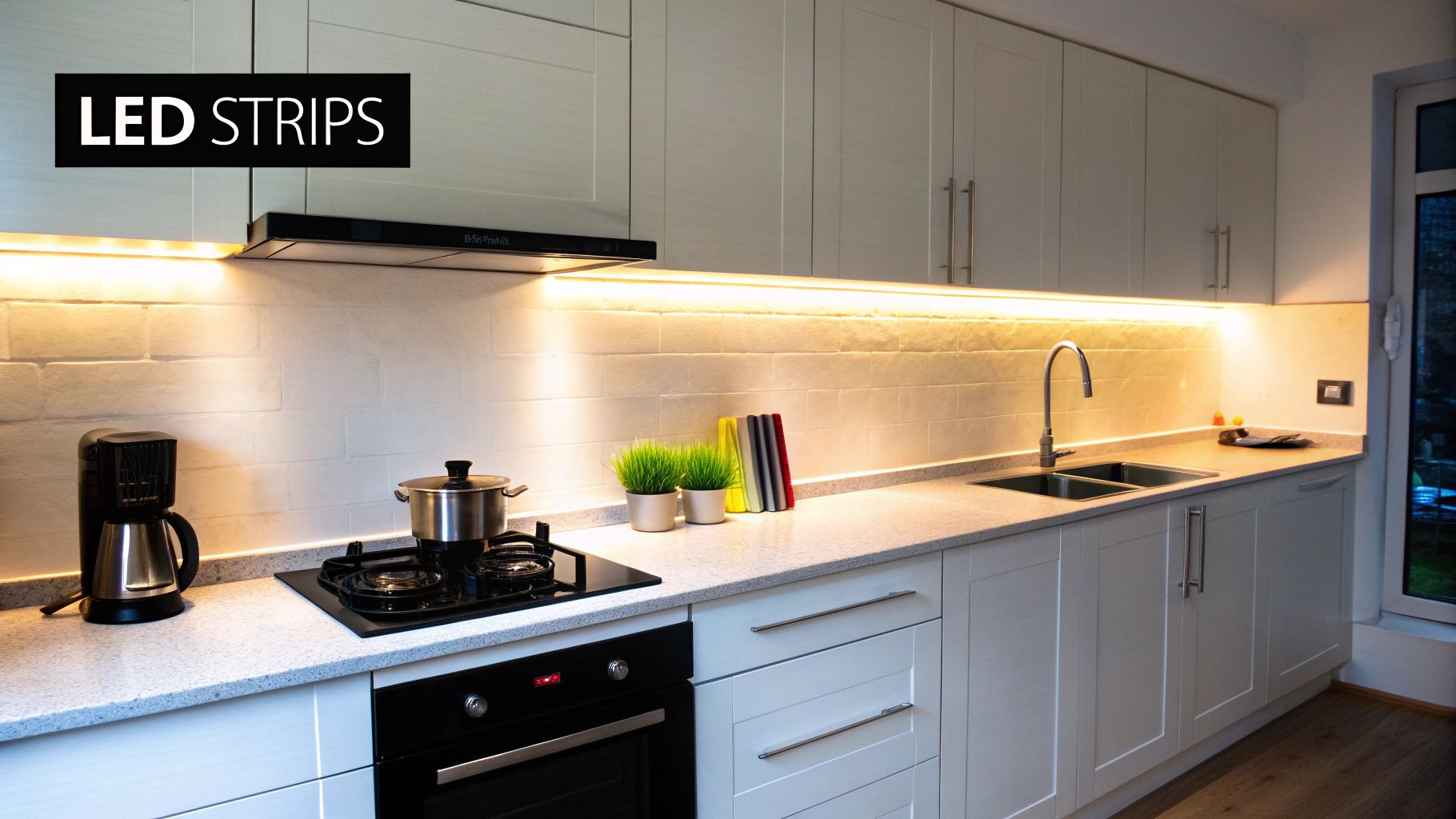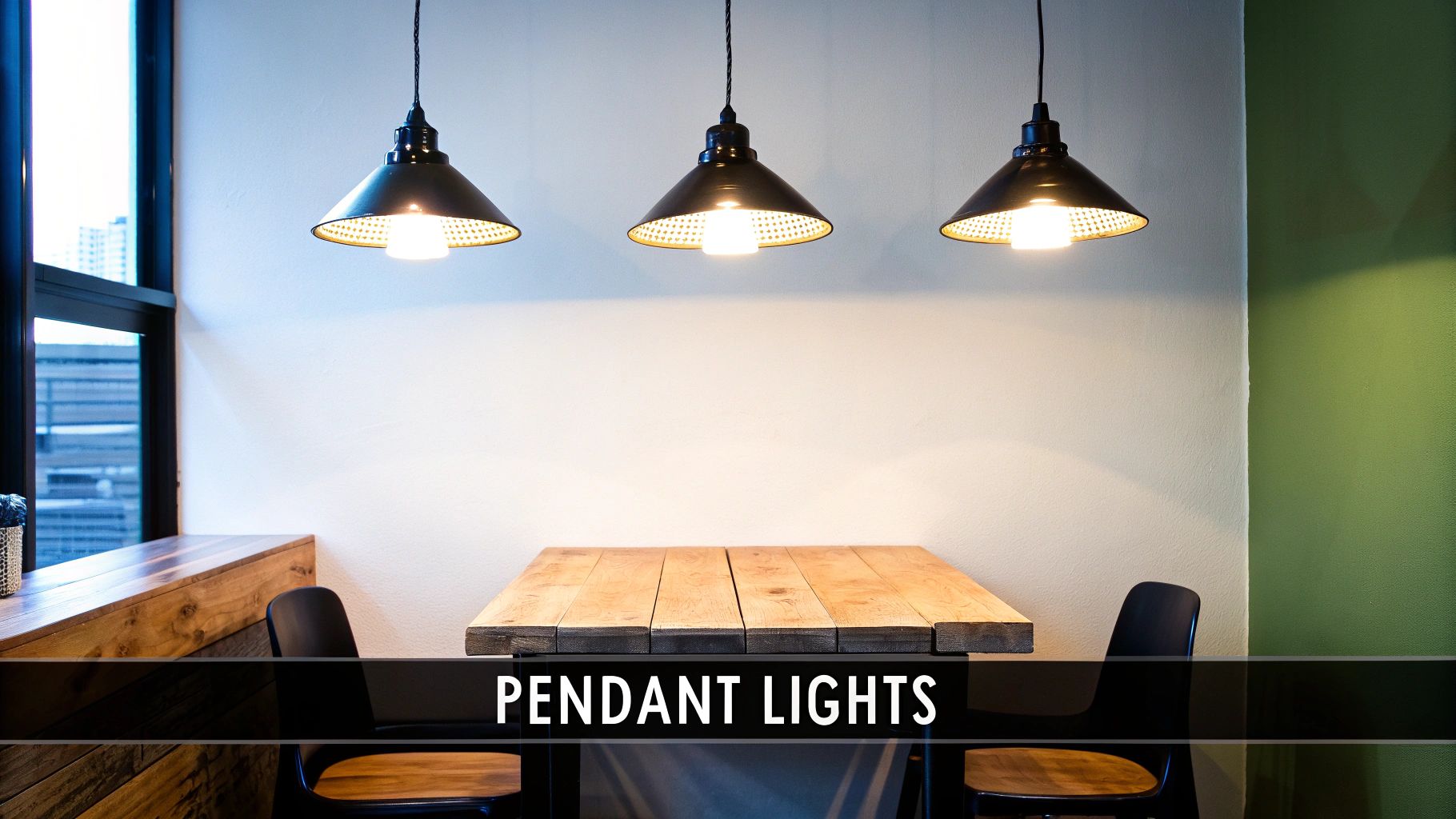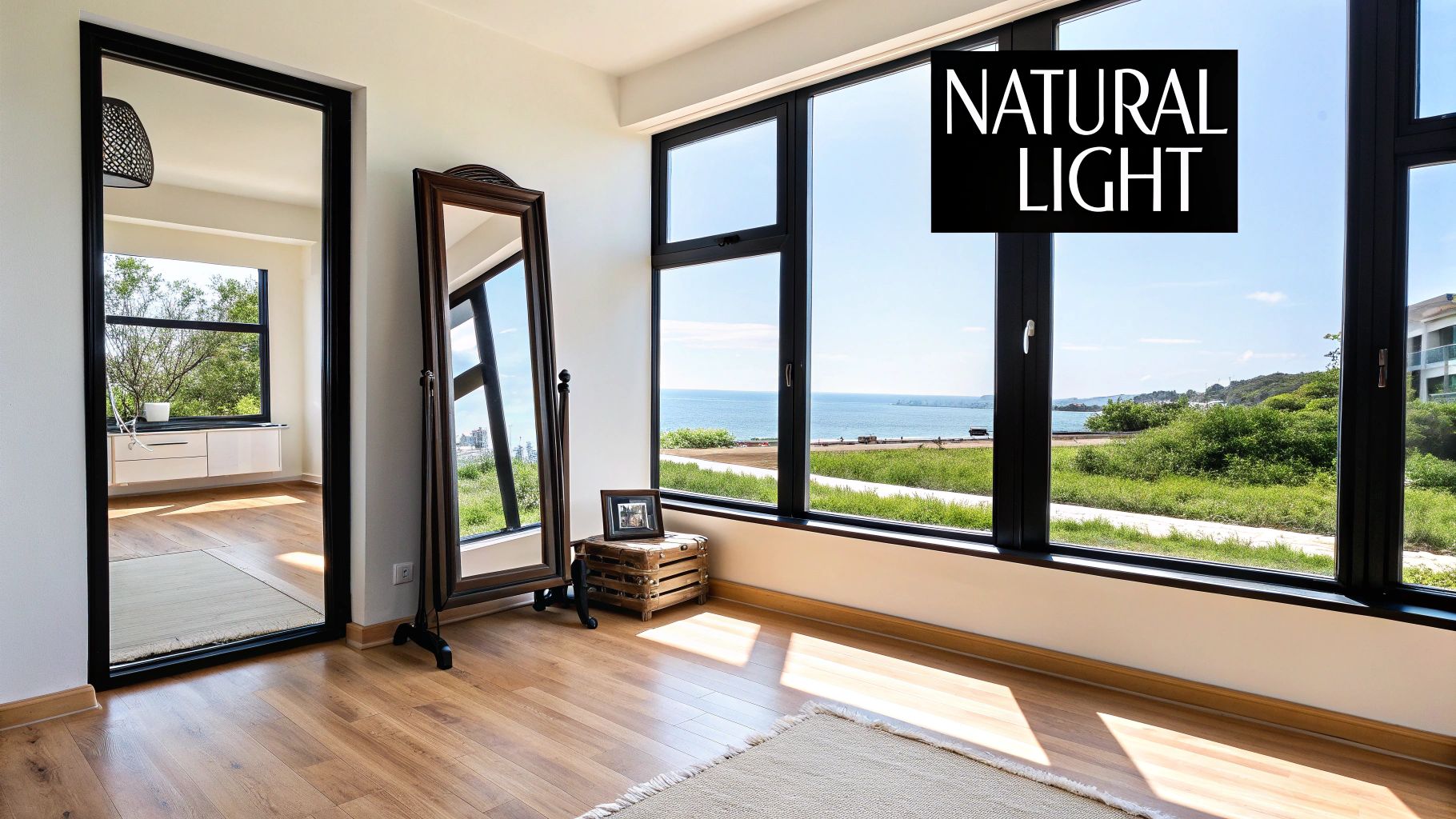The right lighting can completely transform a room, shifting its mood, enhancing its functionality, and highlighting its best features. Many homeowners, however, overlook its potential, often settling for a single, harsh overhead light that does little to create atmosphere. This guide moves beyond the basics, offering a curated collection of nine distinct lighting ideas for home that will help you craft spaces that feel both intentional and inviting. We are here to provide the inspiration and practical steps needed to revitalise your interior design scheme.
From the foundational principles of layered design to the tech-savvy convenience of smart systems, we will explore actionable strategies to brighten every corner of your house. We'll delve into the architectural impact of recessed lighting, the dramatic flair of a statement chandelier, and the subtle ambience created by well-placed wall sconces. Throughout this list, you will find practical tips, real-world examples, and expert advice to help you craft a lighting plan that is both beautiful and perfectly suited to your lifestyle. You will learn how to balance ambient, task, and accent lighting to create a cohesive and dynamic environment. Prepare to see your home in a whole new light.
1. Layered Lighting Design
The foundation of any successful lighting scheme, layered lighting is a professional design technique that ensures a room is both functional and atmospheric. This approach moves beyond a single overhead light, combining three distinct types of illumination to create a cohesive and visually rich environment. By strategically integrating these layers, you can build a flexible space that adapts to any mood or activity, making it one of the most essential lighting ideas for a home.

The Three Layers of Light
This principle, championed by renowned lighting designers like Sally Storey, organises your lighting into three key categories:
- Ambient Lighting: This is your base layer, providing the room's general, overall illumination. Think of it as the substitute for natural daylight. Examples include ceiling-mounted fixtures, recessed downlights, or a large central chandelier.
- Task Lighting: This layer provides focused, direct light for specific activities such as reading, cooking, or working. Effective task lighting includes under-cabinet strips in the kitchen, a floor lamp beside a reading chair, or adjustable desk lamps.
- Accent Lighting: The final, decorative layer. Accent lighting adds drama and draws attention to specific features like artwork, architectural details, or houseplants. Picture lights, wall sconces, and spotlights are common examples.
How to Implement a Layered Scheme
To apply this principle, start with the ambient layer to ensure the entire space is usable. Next, identify activity zones and add dedicated task lighting. Finally, introduce accent lights to create focal points and visual interest. Installing dimmer switches on each layer is crucial; this gives you complete control to adjust the brightness and transition the room’s ambiance from bright and energetic to soft and intimate. Aim for three to five light sources per room to achieve a well-rounded, layered effect.
2. LED Strip Lighting
Once a niche product for professional designers, LED strip lighting has become one of the most versatile and accessible lighting ideas for a home. These flexible strips contain a series of light-emitting diodes (LEDs) and can be cut to size, allowing them to fit into tight spaces and follow unconventional lines. Their ability to provide a continuous, even glow makes them perfect for both functional task lighting and dramatic decorative effects, offering impressive energy efficiency and a long lifespan.

Where to Use LED Strips
The adaptability of LED strips, popularised by systems like Philips Hue, means they can be installed almost anywhere to add a layer of sophisticated light. Common applications include:
- Under-Cabinet Lighting: Illuminates kitchen worktops for food preparation, eliminating shadows cast by overhead lights.
- Cove Lighting: Installed in a recess around the ceiling perimeter, it casts a soft, indirect light upwards, making the room feel larger and more open.
- Staircase Illumination: Placed under the tread of each step, it adds a stunning visual element while improving safety in low-light conditions.
- Backlighting: Fitted behind televisions, computer monitors, or headboards, it reduces eye strain and creates a modern, ambient halo effect.
How to Install LED Strips Effectively
For a polished, professional result, plan your installation carefully. Always use an aluminium channel or profile to house the strip; this not only creates a clean, finished look but also acts as a heat sink, prolonging the life of the LEDs. Before full installation, test the colour temperature to ensure it matches your desired atmosphere. Finally, ensure you choose high-quality controllers and power supplies, especially for colour-changing RGB strips, to guarantee smooth operation and reliable performance.
3. Smart Lighting Systems
Intelligent lighting represents the future of home illumination, moving beyond simple on/off switches to offer fully customisable and automated experiences. These systems use connected bulbs and fixtures that can be controlled remotely via smartphone apps, voice commands to assistants like Amazon Alexa or Google Home, or pre-set schedules. This technology allows you to adjust brightness, change colours, and create dynamic lighting scenes, transforming your home’s atmosphere with unparalleled convenience and control.

The Components of a Smart System
Pioneered by brands like Philips Hue and Lutron, smart lighting integrates seamlessly into modern life. The core components typically include:
- Smart Bulbs & Fixtures: These are Wi-Fi or Bluetooth-enabled lights that replace your standard bulbs. They can be simple white dimmable bulbs or advanced full-colour versions.
- A Hub or Bridge: Some systems require a central hub that connects your lights to your home's Wi-Fi network. This allows for more stable control and expanded features.
- Control Interface: This is how you interact with your lights. It can be a dedicated app on your phone, a physical smart switch or remote, or your favourite voice assistant.
How to Implement Smart Lighting
Integrating smart lighting is simpler than ever. Start small by replacing bulbs in a single room, such as the living room or bedroom, to test the system. Ensure you have strong Wi-Fi coverage for reliable connectivity. When choosing a system, prioritise one that is compatible with your existing smart home ecosystem (e.g., Apple HomeKit, Amazon Alexa). You can then set up automated schedules, such as "Wake Up" scenes that gradually brighten your lights in the morning or "Movie Night" settings that dim them for an immersive experience. Regularly updating the firmware is crucial for security and access to new features.
4. Pendant Lighting
Pendant lights are fixtures suspended from the ceiling by a cord, chain, or rod, acting as both a functional light source and a striking decorative statement. Often referred to as "jewellery for a room", they provide focused illumination while serving as a powerful focal point. This versatility makes them one of the most popular lighting ideas for a home, perfectly suited for defining spaces and adding a touch of personality.

Where Pendants Shine
Popularised by designers like Tom Dixon and embraced in contemporary kitchen design, pendants excel at anchoring specific zones within a home. Their targeted light makes them ideal for task and accent lighting roles.
- Kitchen Islands: A row of three pendants hung over a kitchen island is a classic design choice, providing excellent task lighting for food preparation and creating a social hub.
- Dining Tables: A single large drum pendant or a cluster of smaller lights hung above a dining table defines the eating area and sets an intimate mood.
- Bedside Lighting: Swapping traditional bedside lamps for mini pendants frees up surface space on your nightstand and adds a sleek, modern touch.
- Entryways and Hallways: A dramatic pendant in a foyer makes a memorable first impression, while a series down a long hallway can guide the eye and add visual rhythm.
How to Implement Pendant Lighting
Correct placement is key to maximising the impact of pendant lights. For kitchen islands, hang the base of the fixture 30-36 inches (76-91 cm) above the countertop. Over a dining table, the ideal height is 30-34 inches (76-86 cm) above the tabletop to avoid obstructing views. When using multiple pendants in a row, an odd number (like three or five) often creates a more balanced and visually appealing arrangement. Always consider the scale of the room; a large, open-plan space can handle a substantial fixture, while a smaller room requires a more delicate design. Installing a dimmer switch is essential for adjusting the brightness from functional to atmospheric.
5. Recessed Lighting
Recessed lighting offers a clean, streamlined aesthetic by installing light fixtures directly into hollow openings in the ceiling, leaving only a subtle trim visible. Also known as downlights or can lights, this technique provides excellent ambient and task illumination without visually cluttering a space. Its minimalist profile makes it a versatile choice that seamlessly integrates into almost any décor style, from ultra-modern to traditional, delivering powerful lighting ideas for a home where architectural purity is key.
Key Applications for Recessed Lighting
Popularised by mid-century modern architects and contemporary home builders, recessed lighting is prized for its ability to create a "wash" of light or highlight specific features. Its strength lies in providing a clean base layer of illumination that can be supplemented with other fixtures.
- General Ambient Light: When spaced evenly across a ceiling, recessed lights provide broad, uniform illumination ideal for kitchens, basements, or living rooms. They effectively replace a single central fixture for a more modern feel.
- Task-Oriented Zones: In a kitchen, positioning downlights directly over countertops ensures work surfaces are well-lit. In a home office or study, they can illuminate the primary desk area without causing glare on screens.
- Architectural Highlighting: Use adjustable "gimbal" fixtures to direct light towards a feature wall, piece of art, or fireplace. This turns them into accent lights, adding depth and drama to the room’s design.
How to Implement Recessed Lighting
A successful recessed lighting plan requires careful consideration of placement and type. Start by mapping out a grid, typically spacing fixtures between 4 to 6 feet apart for even coverage. Always use IC-rated (Insulation Contact) fixtures if they will be near ceiling insulation to prevent a fire hazard. Consider adjustable spotlights for flexibility and choose trim styles, from simple white rings to decorative metal finishes, that complement your interior design. For a professional finish, plan your layout before installation to avoid ceiling joists and other structural elements.
6. Statement Chandeliers
More than just a source of light, a statement chandelier is a piece of suspended art that serves as a dramatic focal point in any room. These large, decorative fixtures combine powerful ambient lighting with bold visual impact, instantly defining a space's character and elevating its design. From traditional crystal masterpieces to contemporary geometric sculptures, statement chandeliers are one of the most effective lighting ideas for a home looking to make a memorable impression.
Defining a Space with Light
Popularised by high-end interior designers like Kelly Wearstler and luxury brands such as Baccarat, the statement chandelier has become a go-to for creating a sense of grandeur and purpose.
- Dining Rooms: A classic crystal or modern sputnik chandelier hung above a dining table creates an intimate, sophisticated setting for meals and gatherings.
- Foyers and Entrances: A grand chandelier in a double-height entrance makes a stunning first impression, welcoming guests with style and warmth.
- Living Rooms: An artistic blown glass or rustic wood and metal chandelier can anchor a seating area, adding personality and a central design element.
- Bedrooms and Bathrooms: In unexpected places, a smaller-scale statement chandelier can introduce a touch of boutique hotel luxury and glamour.
How to Select and Install a Chandelier
Choosing the right chandelier involves balancing scale, style, and safety. A simple rule for sizing is to add the room's length and width in feet, then use that number as the chandelier's diameter in inches. For example, a 12ft by 14ft room would suit a 26-inch diameter fixture.
When hanging, ensure it is 30-34 inches above a dining table or at least 7 feet from the floor in living areas and hallways for comfortable clearance. Always verify that your ceiling and mounting hardware can support the fixture's weight, and install a dimmer switch. This vital addition allows you to transition the mood from bright and functional to soft and atmospheric with ease.
7. Wall Sconces
Wall sconces are versatile, space-saving fixtures that offer a sophisticated way to introduce layers of light at eye level. By mounting directly to the wall, they free up valuable floor and surface space, making them one of the most practical lighting ideas for a home of any size. From creating a warm, ambient glow in a hallway to providing focused task lighting beside a bed, sconces add architectural interest and enhance the overall design aesthetic.
Sconces for Ambiance and Function
Popularised by mid-century visionaries and refined by contemporary designers, sconces serve multiple purposes. They can wash a wall with soft, indirect light or cast a direct beam for specific activities, blending form and function seamlessly. Their ability to add depth without cluttering a room makes them invaluable.
- Ambient and Accent Lighting: In a living room or hallway, sconces can frame a piece of artwork or a fireplace, adding a layer of accent light. Uplighting sconces are particularly effective, drawing the eye upwards and making a ceiling feel higher.
- Targeted Task Lighting: Swing-arm sconces flanking a bed are a classic choice for reading, offering adjustable light exactly where it's needed. In a bathroom, placing sconces on either side of a vanity mirror provides even, shadow-free illumination for grooming.
- Creating Symmetry and Balance: Used in pairs, sconces establish a sense of symmetry and order. They are perfect for flanking doorways, windows, or a console table, creating an elegant and organised look.
How to Implement Wall Sconces
Proper placement is key to maximising the impact of wall sconces. For general ambient lighting in hallways or living rooms, a good rule of thumb is to install them between 60 to 66 inches from the floor. When used as bedside reading lights, mount them 18 to 24 inches above the mattress. For bathroom vanities, space them 36 to 40 inches apart to ensure your face is lit evenly. Consider hardwired options for a clean, built-in appearance or plug-in models for an easier, renter-friendly installation.
8. Track and Rail Lighting
Once reserved for art galleries and commercial spaces, track and rail lighting systems offer a highly flexible and modern solution for home illumination. This system involves mounting multiple, individual light fixtures, known as heads, onto a continuous track or rail. This design allows you to easily reposition, add, or remove light heads, giving you complete control to direct light exactly where it is needed. This adaptability makes it one of the most practical lighting ideas for a home with evolving needs.
A System of Adaptable Illumination
Drawing inspiration from its commercial roots, pioneered by innovators like Juno Lighting, track lighting excels at creating dynamic and focused lighting schemes. Its versatility makes it a superb choice for various applications throughout the home:
- Highlighting Features: Use it to create an art gallery effect, washing walls with light or spotlighting individual artworks, photographs, or architectural details like a textured brick wall.
- Task-Oriented Lighting: In a kitchen, a track system can be positioned over an island or countertops to provide bright, targeted light for food preparation, eliminating shadows from overhead fixtures.
- Multi-functional Spaces: It is ideal for open-plan living areas or studios where you might need to change the lighting layout to suit different activities, from entertaining to working.
How to Implement Track and Rail Lighting
For best results, plan the track's layout to complement the room's function without interfering with tall furniture. To minimise glare on artwork or walls, aim the light heads at a 30-degree angle. Combine different head types, using spotlights for accenting and wider floodlights for broader illumination. Installing a dimmer switch is crucial, allowing you to transition from bright, functional light to a softer, ambient mood. Choose high-quality fixtures to ensure the heads glide smoothly along the track for easy adjustments.
9. Natural Light Optimization
The most fundamental light source is the sun, and optimising its presence indoors is one of the smartest and most sustainable lighting ideas for a home. This approach focuses on architectural and interior design strategies that maximise the flow and reflection of daylight, reducing the need for artificial lighting. Championed by Scandinavian design and biophilic principles, this technique creates bright, airy, and energy-efficient spaces that actively promote well-being.
Harnessing and Enhancing Daylight
The core principle is to treat natural light as a precious resource and design your space to manage it effectively. This involves more than just having large windows; it's about guiding light into the deepest corners of your home.
- Reflective Surfaces: The strategic use of surfaces is key. Light-coloured paints, particularly in satin or semi-gloss finishes, bounce light around a room. Similarly, polished flooring, gloss kitchen cabinets, and metallic finishes can significantly amplify brightness.
- Window Treatments: Heavy, opaque curtains absorb light and shrink a room visually. Instead, opt for sheer voiles or light-filtering blinds that maintain privacy while allowing soft, diffused daylight to stream through.
- Architectural Solutions: For homes with deep floor plans or dark corridors, structural changes can be transformative. Installing skylights, light tunnels (or sun pipes), or even interior glass panels can introduce daylight into areas that windows cannot reach.
How to Maximise Natural Light
Start by assessing how sunlight moves through your home during the day. Place a large mirror directly opposite your main window to effectively double the amount of light and create an illusion of greater space. Keep windows clean inside and out, as grime can reduce light transmission significantly. When redecorating, choose paints in light neutrals, soft pastels, or off-whites for both walls and ceilings to create a bright, reflective canvas.
Lighting Ideas Comparison Matrix
Bringing Your Lighting Vision to Life
As we have explored, mastering the art of illumination is one of the most transformative skills you can bring to your interior design. The journey from a simply lit room to a thoughtfully illuminated sanctuary is not about a single, perfect fixture but about the sophisticated interplay of different light sources. By embracing the principles we've discussed, you are now equipped to move beyond basic visibility and start crafting atmosphere, mood, and function with precision and creativity.
Key Takeaways for a Brilliantly Lit Home
Reflecting on the array of lighting ideas for home, a few core concepts stand as the foundation for any successful scheme. The principle of layered lighting is paramount; it is the strategic combination of ambient, task, and accent lighting that gives a room its depth and versatility. Think of it as painting with light, where each layer adds a new dimension to the overall picture.
Furthermore, modern technology has opened up unprecedented possibilities. Smart lighting systems and versatile LED strips are no longer niche gadgets but essential tools for creating dynamic, responsive environments. They empower you to change your home’s entire feel with a simple command or a tap on your phone, adapting to your daily rhythms from a vibrant morning workspace to a tranquil evening retreat.
The most impactful lighting design is not static. It is a flexible, living element of your home that evolves with your needs, the time of day, and the seasons.
Your Actionable Next Steps
To translate these ideas into reality, start with a focused approach. Don't feel pressured to overhaul your entire home at once. Instead, choose one room and perform a lighting audit.
- Assess the Current State: Identify what works and what doesn't. Where are the dark corners? Where do you need focused light for activities like reading or cooking?
- Define the Room's Purpose: Consider all the ways you use the space. A living room might need bright, energetic light for social gatherings but also soft, warm light for relaxing.
- Sketch a Simple Plan: Draw a basic layout of the room and mark where you will place your three layers of light. Could a statement chandelier provide the ambient glow? Where would wall sconces add a touch of accent elegance? Is there a spot under a cabinet crying out for a practical LED strip?
This methodical process demystifies the task and turns it into a manageable and enjoyable project. Experimenting with different fixture types, from bold pendant lights over a kitchen island to discreet recessed lighting that washes a wall with light, will build your confidence. Remember to incorporate dimmers wherever possible; they are the single most effective tool for controlling mood and are a non-negotiable element in a sophisticated lighting plan. By taking these deliberate steps, you will see how a thoughtful approach to light can dramatically enhance not just your décor, but your quality of life within your home.
Ready to find the perfect fixtures to illuminate your space? Explore the curated collections at Spruce Collective. From statement pieces to essential accent lights, discover unique, high-quality designs and expert inspiration to bring your lighting ideas for home to life. Visit Spruce Collective to begin your design journey today.
Article created using Outrank




